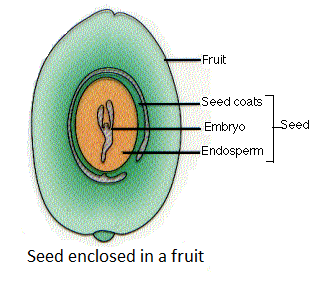
Seed coat is not thin, but membranous in
A. Maize
B. Coconut
C. Groundnut
D. Gram
Answer
561.3k+ views
Hint: Seed coat is the outer protective covering of seeds that resist deterioration of the quality of seeds. It is a thin but strong covering present externally. The seed coat emerges from the maternal tissue that arises from the integument and ovule. In some seeds like in peanuts, the seeds are fragile. On the other hand, seeds belonging to drupe fruit have a membranous seed coat.
Complete answer: The seed coat is the protective covering of the seeds present externally to the seed body. A seed is the potential embryological plant that is enclosed in the seed coat. The seeds are the result of the reproduction process in the plants. The seed coat develops from the two integuments or it is formed by outer layers of ovule cells. The seed coats are modified distinctly in different species of plants. In drupes that are fleshy fruits, the seed coat is usually membranous. The coconut fruit is indehiscent. It has an outer fleshy part called exocarp or skin that is surrounded by mesocarp or flesh from inside. The mesocarp further encloses a shell of hardened endocarp having a seed inside it. The fruit develops from a single carpel and flowers having superior ovaries. The coconut is a drupe or a fleshy fruit having hard lignified stone derived from the wall of the ovary. The seed coat is thus not thin, but membranous and tough.

Let us understand the seed structure and morphology of other given plant species.
-In maize plants, the leafy stalk produces pollen inflorescences and ovuliferous inflorescences that are known as ears. These ears change into kernels or seeds. The seed coat is thin consisting of two outer layers of the kernel.
-In the groundnut, the seeds from the edible parts. These seeds are termed nuts. They have very thin paper-like seed coats.
-In grams also the seed forms the edible part. They are covered by a hard but thin seed coat.
Therefore, the right answer is coconut, option B.
Note: The seed coat functions to protect the enclosed embryo so that it can flourish on the arrival of suitable conditions. Also, the seed coat determines the germination of the seeds. They slow down water absorption and discourage seeds from starting growing until spring or suitable conditions arrive. The seed coat also protects the seed from being eaten by insects.
Complete answer: The seed coat is the protective covering of the seeds present externally to the seed body. A seed is the potential embryological plant that is enclosed in the seed coat. The seeds are the result of the reproduction process in the plants. The seed coat develops from the two integuments or it is formed by outer layers of ovule cells. The seed coats are modified distinctly in different species of plants. In drupes that are fleshy fruits, the seed coat is usually membranous. The coconut fruit is indehiscent. It has an outer fleshy part called exocarp or skin that is surrounded by mesocarp or flesh from inside. The mesocarp further encloses a shell of hardened endocarp having a seed inside it. The fruit develops from a single carpel and flowers having superior ovaries. The coconut is a drupe or a fleshy fruit having hard lignified stone derived from the wall of the ovary. The seed coat is thus not thin, but membranous and tough.

Let us understand the seed structure and morphology of other given plant species.
-In maize plants, the leafy stalk produces pollen inflorescences and ovuliferous inflorescences that are known as ears. These ears change into kernels or seeds. The seed coat is thin consisting of two outer layers of the kernel.
-In the groundnut, the seeds from the edible parts. These seeds are termed nuts. They have very thin paper-like seed coats.
-In grams also the seed forms the edible part. They are covered by a hard but thin seed coat.
Therefore, the right answer is coconut, option B.
Note: The seed coat functions to protect the enclosed embryo so that it can flourish on the arrival of suitable conditions. Also, the seed coat determines the germination of the seeds. They slow down water absorption and discourage seeds from starting growing until spring or suitable conditions arrive. The seed coat also protects the seed from being eaten by insects.
Recently Updated Pages
Why are manures considered better than fertilizers class 11 biology CBSE

Find the coordinates of the midpoint of the line segment class 11 maths CBSE

Distinguish between static friction limiting friction class 11 physics CBSE

The Chairman of the constituent Assembly was A Jawaharlal class 11 social science CBSE

The first National Commission on Labour NCL submitted class 11 social science CBSE

Number of all subshell of n + l 7 is A 4 B 5 C 6 D class 11 chemistry CBSE

Trending doubts
10 examples of friction in our daily life

One Metric ton is equal to kg A 10000 B 1000 C 100 class 11 physics CBSE

Difference Between Prokaryotic Cells and Eukaryotic Cells

1 Quintal is equal to a 110 kg b 10 kg c 100kg d 1000 class 11 physics CBSE

State the laws of reflection of light

Explain zero factorial class 11 maths CBSE




